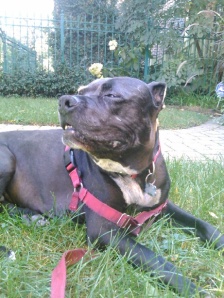 Many people may be conflicted about treating their dogs’ cancer outside of the traditional medicine protocol. I am not here to try to convince anyone of anything, but if I can help swing the scales a bit for someone already leaning towards natural remedies, I’d like to share my three reasons for choosing the natural route for Bart.
Many people may be conflicted about treating their dogs’ cancer outside of the traditional medicine protocol. I am not here to try to convince anyone of anything, but if I can help swing the scales a bit for someone already leaning towards natural remedies, I’d like to share my three reasons for choosing the natural route for Bart.
1. It’s a harsh fact to consider, but our animal friends’ life spans are regretfully shorter than that of an average human, even if they remain healthy all their years. This is obvious, but I really do think that in times of duress and panic involving your dog’s health, many people somehow shut themselves off to this fact. We all do it in one way or another regarding a myriad of issues. It’s called cognitive dissonance*, and it basically means that under certain circumstances human nature clouds our clear thinking. So when considering the lifespan of our four-legged babies, it is wise to ask yourself a few questions. If your dog is a senior: “Is my senior dog simply at the end of his or her life, and should I prepare for letting him or her go?” If your dog is not a senior, but a young adult, “Would he or she choose chemotherapy if they had the ability to understand what it is and what it entails?” “Is it actually worth putting my dog through more pain and anxiety?” And another important question to ask that unfortunately must be addressed, “Can I afford conventional treatments even if they fail?” The amount of time Bart was given by the oncologist with chemotherapy was going to only be 8 months and 3 months if I chose “nothing,” which is possibly how this doctor would consider the path I took. Well it has been over 3 years now, and Bart is a mature 11 years old.
2. For me, the most important reason I chose to go this route with Bart was the fact that I knew he would be happy eating home cooked meals even if he only lived for a few more weeks or months. I just wanted to make him as comfortable and as happy as I could before we have to say goodbye. I have definitely succeeded here. He seemed happier these past 3 years than he had his whole life. He really loves his meals.
3. The cost of feeding your dog a whole food diet varies depending on the size of your dog, but the cost of conventional chemotherapy does not. Conventional medicine is expensive and extensive. A Whole Foods diet for you dog will cost you more than kibble, and it is a commitment, but it is far cheaper than conventional methods, prescriptions, chemotherapy, radiation, surgery and doctor’s appointments.
*wikipedia: In psychology, cognitive dissonance is the mental stress or discomfort experienced by an individual who holds two or more contradictory beliefs, ideas, or values at the same time, or is confronted by new information that conflicts with existing beliefs, ideas, or values.
Check out the anti-cancer diet I’ve been using with Bart for the past 3+ years: https://doggeared.wordpress.com/an-anti-cancer-diet-for-dogs/
If you have success stories of your own, please feel free to share them on this blog by hitting reply. I would love to hear from you!
















